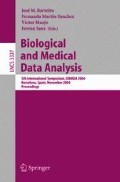Abstract
Computer assisted processing of long-term EEG recordings is gaining a growing importance. To simplify the work of a physician, that must visually evaluate long recordings, we present a method for automatic processing of EEG based on learning classifier. This method supports the automatic search of long-term EEG recording and detection of graphoelements – signal parts with characteristic shape and defined diagnostic value. Traditional methods of detection show great percent of error caused by the great variety of non-stationary EEG. The idea of this method is to break down the signal into stationary sections called segments using adaptive segmentation and create a set of normalized discriminative features representing segments. The groups of similar patterns of graphoelements form classes used for the learning of a classifier. Weighted features are used for classification performed by modified learning classifier fuzzy k – Nearest Neighbours. Results of classification describe classes of unknown segments. The implementation of this method was experimentally verified on a real EEG with the diagnosis of epilepsy.
Access this chapter
Tax calculation will be finalised at checkout
Purchases are for personal use only
Preview
Unable to display preview. Download preview PDF.
References
Davey, B.L.K., et al.: Expert system approach to detection of epileptiform activity in the EEG. Med. Biol. Eng. Comput. 27(4), 365–370 (1989)
Gotman, J.: Automatic recognition of epileptic seizure in the EEG. Electroencephalogr. Clin. Neurophysiol. 83, 271–280 (1982)
Qu, H., Gotman, J.: Improvement in seizure detection performance by automatic adaptation to the EEG of each patient. Electroencephalogr. Clin. Neurophysiol. 86, 79–87 (1993)
Mayer-Kress, G.: Localized measures for nonstationary time-series of physiological data. Integrative Physiological Behav. Sci. 29(3), 205–210 (1994)
Petrosian, A., Homan, R.W., Pemmaraju, S., Mitra, S.: Wavet-based texture analysis of EEG signal for prediction of epileptic seizure. In: SPIE Proceedings on Wavelet Applications in Signal and Image Processing, San Diego, CA, vol. 2569, pp. 189–194 (1995)
Weng, W., Khorasani, K.: An adaptive structure neural networks with application to EEG automatic seizure detection. Neural Networks 9(7), 1223–1240 (1996)
Hornero, R., Espino, P., Alonso, A., Lopez, M.: Estimating Complexity from EEG Background Activity of Epileptic Patients. IEEE Engineering in Medicine and Biology, 73–79 (1999)
Smith, S.W.: Digital Signal Processing, San Diego, CA, USA. California Technical Publishing (1997)
Bodenstein, G., Praetorius, H.M.: Feature extraction from the electroencephalogram by adaptive segmentation. Proc. IEEE 65, 642–652 (1977)
Krajca, V., Petranek, S., Ondruska, V., Doruzkova, J., Pecharova, D.: Multichannel adaptive segmentation. Basis for EEG record pre-processing, Lekar a technika 2(23), 28–34 (1992)
Varri, A.: Digital Processing of the EEG in Epilepsy. Tampere University of Technology, Pori (1988)
Krajca, V., Petranek, S., Patakova, I., Varri, A.: Automatic identification of significant graphoelements in multichannel EEG recordings by adaptive segmentation and fuzzy clustering. Int. Journal Biomed. Comput. 28, 71–89 (1991)
Agarwal, R., Gotman, J., Flanagan, D., Rosenblan, B.: Automatic EEG analysis during longterm monitoring in the ICU. Electroencephalography and Clinical Neurophysiology 107(1), 44–58 (1998)
Plotkin, E.I., Swamy, M.N.S.: Nonlinear signal processing based on parameter invariant moving average modeling. In: Proceedings CCECE ’21, Toronto, Canada, pp. TM3.11.1-TM3.11.4 (September 1992)
Cover, T.M., Hart, P.E.: Nearest neighbour pattern classification. IEEE Transaction Inform. Theory IT-13, 21–27 (1967)
Keller, J.M., Gray, M.R., Givens, J.A.: A Fuzzy K-Nearest Neighbor Algorithm. IEEE Transactions on systems, man. and cybernetics SMC-15(4), 580–585 (1985)
Author information
Authors and Affiliations
Editor information
Editors and Affiliations
Rights and permissions
Copyright information
© 2004 Springer-Verlag Berlin Heidelberg
About this paper
Cite this paper
Kosar, K., Lhotska, L., Krajca, V. (2004). Classification of Long-Term EEG Recordings. In: Barreiro, J.M., Martín-Sánchez, F., Maojo, V., Sanz, F. (eds) Biological and Medical Data Analysis. ISBMDA 2004. Lecture Notes in Computer Science, vol 3337. Springer, Berlin, Heidelberg. https://doi.org/10.1007/978-3-540-30547-7_33
Download citation
DOI: https://doi.org/10.1007/978-3-540-30547-7_33
Publisher Name: Springer, Berlin, Heidelberg
Print ISBN: 978-3-540-23964-2
Online ISBN: 978-3-540-30547-7
eBook Packages: Springer Book Archive

